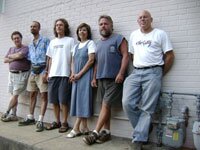COVER- Dialed up: Group hopes to launch local talk radio

Ken Zelin, Alexis Zeigler, Kai Safran, Rebecca Faris, Mike Craig, and Shellen Inglima of the Blue Ridge Radio Project will send their application for a full-power, non-commercial radio station to the FCC in October.
PHOTO BY LINDSAY BARNES
Is there room for one more radio station in Charlottesville? That's a question the Federal Communications Commission is about to answer when it determines the fate of an upstart group of local airwave enthusiasts who say there's a market that's unsatisfied.
"We want to give a voice to those who don't have a voice," says Rebecca Faris, co-founder of the Blue Ridge Radio Project (BRRP). "We want radio that's independent, local, diverse and educational, and we want it to come from the community itself."
The idea began when Faris heard in January that the FCC had decided to accept applications for non-commercial educational radio licenses, providing the opportunity she had been awaiting for two years. Since October 2005, the Charlottesville resident and lifelong activist has commuted to Richmond once a week to host the half-hour talk program "Richmond IndyMedia Live" on independent FM station 97.3 WRIR.
"When I first walked into WRIR," she explains, "I saw the potential of what it meant to become part of the media, and I wanted to bring that same feeling of empowerment to Charlottesville."
So with the help of a coalition with members ranging from a former A/V chief at Yogaville to a professional musician who builds low-power FM transmitters in his spare time, she launched BRRP as a free platform for local people to create and air programming about what matters to them.
"There's so much more that we can do than what's on the radio now," says BRRP co-founder Alexis Zeigler. "People who do counseling; people who want to do a show on nutrition; people who have ideas about sustainable living– they're all limited to these 30-second spots or filtering their message through government officials and rock stars."
If this sounds familiar, it's because many of those involved with this current venture were also involved with CvilleIndyMedia.org, a website launched in February 2004 to air liberal causes and news. According to Faris, the site had a two-year run, cut short only by a key personnel loss.
"Our tech guys moved away," she says.
Central Virginia already has a modicum of local talk. Between Coy Barefoot's daily "Charlottesville: Right Now" on commercial station AM 1070 WINA and Rick Moore's hour-long "Wake-Up Call" on non-commercial 91.9-FM WNRN, listeners can tune into 11 hours of local talk every week– and that's not even counting "The Morning Show with Rick and Jane" at WINA [see related story]. While Faris is complimentary of other local talk shows, she says there just aren't enough hours in the day to cover everything that's worthy of broadcast.
"We want to focus on causes and issues that don't get media attention for whatever reason," she says.
It's that spirit that got the attention of Joe Szakos, executive director of the Virginia Organizing Project. While the VOP board has yet to vote on making the BRRP an official project, Szakos and company have lent a hand to the effort by providing legal and fundraising advice in addition to acting as the official applicant in the eyes of the FCC. Asked why his organization decided to take on that mantle, Szakos says it ultimately comes down to filling a need he's seen as the director of a non-profit.
"I've found that if you want to work on a particular issue, some media sources are going to tell you it's too local and others are going to tell you it's not local enough," he says. "This is going to touch both ends of that spectrum by talking about both local issues and global issues with a local impact, and it will be done in a way that's not connected to a price tag."
Having founded a non-commercial station, WNRN's Mike Friend says this new group is dreaming if they're hoping to snag a frequency of their own.
"There aren't any non-commercial frequencies available. Believe me, I know," Friend says. "We have software that shows us what's available, but all you need to do is some simple math. You can't use anything within 0.8 of any local frequency. So with 91.9, you can't use anything between 91.1 and 92.7. Do that with all the local stations, and you'll see nothing is available."
Faris says her group has done extensive engineering studies to skirt this very problem, and she assures that local bandwidth isn't already saturated.
"The FCC is very specific about overlap and distances between transmitters and topography, down to the most incredible minutiae," she says. "We made sure we were complying with all those rules back in April and May and found there is still bandwidth for us."
Should the BRRP win its construction license, listeners will have to wait a little while to tune in. Once the FCC makes its decision (no date has been announced), the group will have a three-year window to secure a broadcast license and launch the station.
#